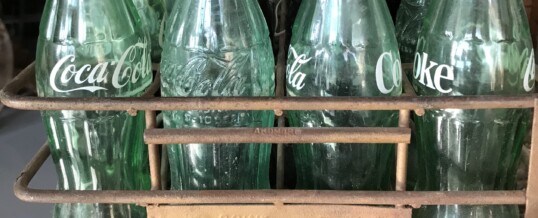
There wasn’t much else that was worse than being assigned to sort the bottle room in back of the Piggly Wiggly. If someone could fit an object in an empty Coke bottle, they’d put it in there.
I called them all Coke bottles, whether they were a Coke product or not. Pepsi, 7up, Dr. Pepper, Grapette – they were all Coke bottles to me and they were all worth money. When I left my career in the grocery business Coke bottles were fetching a nickel apiece.
Young folks today like to fancy themselves as recyclers. But I’m here to tell you, there isn’t anything else more eco-friendly than soda pop bottles that are returned, washed, and refilled with your favorite carbonated beverage.
It seemed everyone who worked at the store got a turn in the back room sorting those bottles, but I’d argue that those of us who did it well and without griping got to do it more often.
For decades, soda bottles were the same as cash to a kid. If you found them fair and square, you could take them to a grocery store and get money for each unbroken one.
Soda bottles were a way to save for something you wanted. You’d see all of the youngsters roaming the roadside ditches, looking for bottles someone else had tossed out the window of their Chevy or Ford. I always said only rich people could afford to litter like that.
Woodsy Owl hadn’t made his debut yet.
If you had a little red wagon, you could come home with as many as it would hold. You’d clean the bottles out, put them back in the wagon, and haul them to the store for cash. (grocery stores wouldn’t pay kids for dirty bottles, but they’d take them from adults buying a buggy full of groceries)
A 50-cent day was a good one. That would buy you and your sister a ton of candy with plenty of money left over.
I’m guessing the city didn’t worry much about cleaning the roadsides when they had the kids doing it for them.
Back to the bottle room at the Piggly Wiggly.
Some grocery stores didn’t have a bottle room. They just put the bottles out behind the store. But the Piggly Wiggly had a concrete room with a water hose. If you were assigned bottle duty, you didn’t leave until each bottle was cleaned and placed into the appropriate wooden or metal bottle rack.
The soda companies didn’t exactly send each other Christmas cards, so they wouldn’t pick up any of their crates that had competitor’s bottles in them.
So, part of your job was to make sure all of the Pepsi bottles were clean and in a Pepsi crate; Dr. Pepper bottles were in a Dr. Pepper crate, and so on.
I gained an entirely new respect for empty soda bottles. Cleaning the bottles of a customer who also enjoyed Red Man will do that for you.
Same was true for Lucky Strike fans who obviously didn’t own an ashtray.
I would spend an entire 8-hour, August Saturday shift cleaning that bottle room, only to see it in disarray come Monday. It was disheartening, but it was a job.
Returnable soda bottles disappeared in most places in the early 90s, which I find sad. It ended the entrepreneurial spirit of children who were broke and without candy, and ensured that perfectly good glass bottles would, going forward, wind up in the landfill.
Some states still offer returns on bottles, but it’s rare.
Today, most soda pop is sold in cans (to me, it tastes like metal) or in plastic (tastes like plastic). There is no substitute for a cold soft drink right out of the bottle. And if you can find one in a bottle made from pure cane sugar, not some syrupy sweetener, you’ve found gold.
Every now and then, I find a Fanta or an Orange Crush in a bottle, and I treat myself. Real soda pops are more expensive, but they’re worth it.
So is recycling pop bottles. It’s worth returning to those.
©2021 John Moore
To send John a message; buy his books, Write of Passage: A Southerner’s View of Then and Now Vol. 1 and Vol. 2, or listen to his Weekly 5-Minute Podcast; visit his website at TheCountryWriter.com.
AUG
2021
